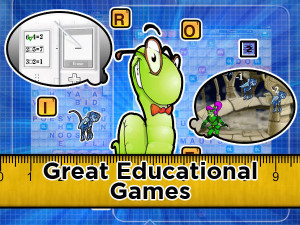Education Computer Games
COMPUTER GAME SUPPLEMENTS
Today the most common form of educational engagement is the computer game. Gaming has been used in educational circles since at least the 1900s. Use of paper-based educational games became popular in the 1960s and 1970s, but waned under the Back to Basics teaching movement (see: The History of Educational Games in Education Game-based eLearning). The use of educational computer games has grown as research and results have shown how effective educational gaming can be. A growing body of university research suggests that gaming improves creativity, decision-making and perception.
In a contemporary classroom model it is typical for the teacher to stand in front of the class and lecture to the students. Since some students will learn at different levels, it is possible  that some students will be held back or some students will be left behind because of the pace of the class. In many good educational video games there are difficulty settings. This allows the player to set a different level of mastery for their individual needs. After the player has achieved mastery over the game, they can up the difficulty setting and be further challenged. Also while the teacher is engaging the class as a whole this allows all student types to advance in subject knowledge at their own pace.
that some students will be held back or some students will be left behind because of the pace of the class. In many good educational video games there are difficulty settings. This allows the player to set a different level of mastery for their individual needs. After the player has achieved mastery over the game, they can up the difficulty setting and be further challenged. Also while the teacher is engaging the class as a whole this allows all student types to advance in subject knowledge at their own pace.
It can be easy for students to get lost in their thoughts and disconnect from what is going on in class. Educational video games tend to be more engaging. Rather than getting a bunch of information over an extended class period, games provide small bits of information at relevant stages. It is true that many things students learn in their classroom will be relevant, but not necessarily at that particular moment. Educational games hold the attention of the player and provide what information is needed for that junction within the game.
Game-based training is a very effective and highly interactive instruction tool. When combined with lecture-based training, educational games can increase participant interest and make the training process more enjoyable, memorable and effective. That’s because today’s students will be tomorrow’s workers, and students today are skilled and accustomed to computer and hand-held technologies for entertainment, communication and learning. The ultimate result of eLearning and educational games is that an individual can apply what he or she has learned to real life situations.
Many educational games also involve varying levels of problem solving, requiring an active mind to help achieve completion of a goal. Not all games do this well, but the good games will provide game play that is do-able, but challenging enough that the student must work at its completion. Because games follow this model, it creates a small degree of frustration in the player but does not deter them from wanting to play. Instead it gives them more motivation to continue on. To get the full benefit from this many games allow players to adjust difficulty levels and allow them to achieve varying levels of mastery over the game
In good education games, they will often find that they will require these skills later on in the game as well, and thus be required to maintain and hone their skills for later on. Educational video games also often provide instant rewards for succeeding in solving a problem. This is in contrast to the classroom where students wait for graded tests and are only rewarded occasionally with report cards to report their progress. Education games can instantly tell a student of failure or success and often this can be used to develop skills along the way.
As the research goes on one thing is certain computer educational games are here to stay. As studies show education video games are a great way to bring a new form of learning into the classroom. When someone plays a education game, they are challenged mentally with a problem. Through playing they will discover many different ways to solve problems they will come across. (see: Education Game-based eLearning)

Recent Comments